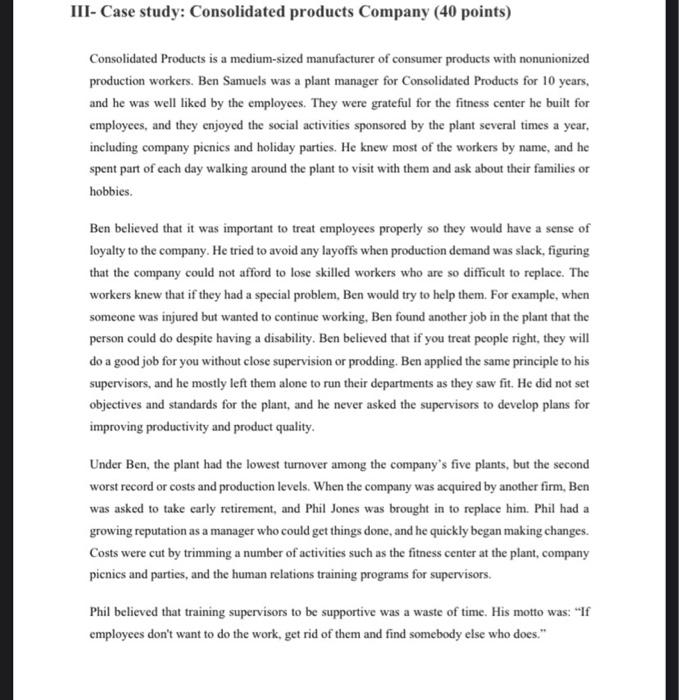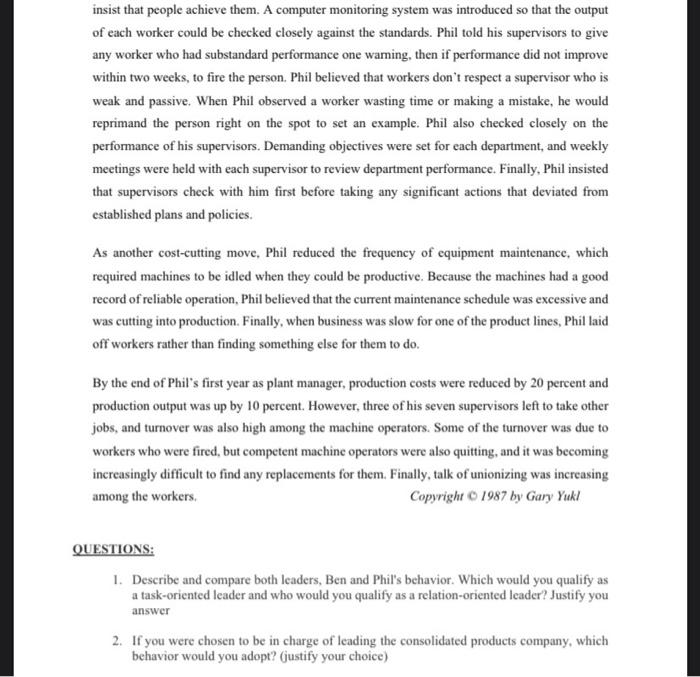III- Case study: Consolidated products Company (40 points) Consolidated Products is a medium-sized manufacturer of consumer products with nonunionized production workers. Ben Samuels was a plant manager for Consolidated Products for 10 years, and he was well liked by the employees. They were grateful for the fitness center he built for employees, and they enjoyed the social activities sponsored by the plant several times a year, including company pienics and holiday parties. He knew most of the workers by name, and he spent part of each day walking around the plant to visit with them and ask about their families or hobbies. Ben believed that it was important to treat employees properly so they would have a sense of loyalty to the company. He tried to avoid any layoffs when production demand was slack, figuring that the company could not afford to lose skilled workers who are so difficult to replace. The workers knew that if they had a special problem, Ben would try to help them. For example, when someone was injured but wanted to continue working, Ben found another job in the plant that the person could do despite having a disability. Ben believed that if you treat people right, they will do a good job for you without close supervision or prodding. Ben applied the same principle to his supervisors, and he mostly left them alone to run their departments as they saw fit. He did not set objectives and standards for the plant, and he never asked the supervisors to develop plans for improving productivity and product quality. Under Ben, the plant had the lowest turnover among the company's five plants, but the second worst record or costs and production levels. When the company was acquired by another firm, Ben was asked to take early retirement, and Phil Jones was brought in to replace him. Phil had a growing reputation as a manager who could get things done, and he quickly began making changes. Costs were cut by trimming a number of activities such as the fitness center at the plant, company picnics and parties, and the human relations training programs for supervisors. Phil believed that training supervisors to be supportive was a waste of time. His motto was: "If employees don't want to do the work, get rid of them and find somebody else who does." insist that people achieve them. A computer monitoring system was introduced so that the output of each worker could be checked closely against the standards. Phil told his supervisors to give any worker who had substandard performance one waming, then if performance did not improve within two weeks, to fire the person. Phil believed that workers don't respect a supervisor who is weak and passive. When Phil observed a worker wasting time or making a mistake, he would reprimand the person right on the spot to set an example. Phil also checked closely on the performance of his supervisors. Demanding objectives were set for each department, and weekly meetings were held with each supervisor to review department performance. Finally, Phil insisted that supervisors check with him first before taking any significant actions that deviated from established plans and policies. As another cost-cutting move, Phil reduced the frequency of equipment maintenance, which required machines to be idled when they could be productive. Because the machines had a good record of reliable operation, Phil believed that the current maintenance schedule was excessive and was cutting into production. Finally, when business was slow for one of the product lines, Phil laid off workers rather than finding something else for them to do. By the end of Phil's first year as plant manager, production costs were reduced by 20 percent and production output was up by 10 percent. However, three of his seven supervisors left to take other jobs, and turnover was also high among the machine operators. Some of the turnover was due to workers who were fired, but competent machine operators were also quitting, and it was becoming increasingly difficult to find any replacements for them. Finally, talk of unionizing was increasing among the workers. Copyright 01987 by Gary Yukl QUESIIONS: 1. Describe and compare both leaders, Ben and Phil's behavior. Which would you qualify as a task-oriented leader and who would you qualify as a relation-oriented leader? Justify you answer 2. If you were chosen to be in charge of leading the consolidated products company, which behavior would you adopt? (justify your choice)








